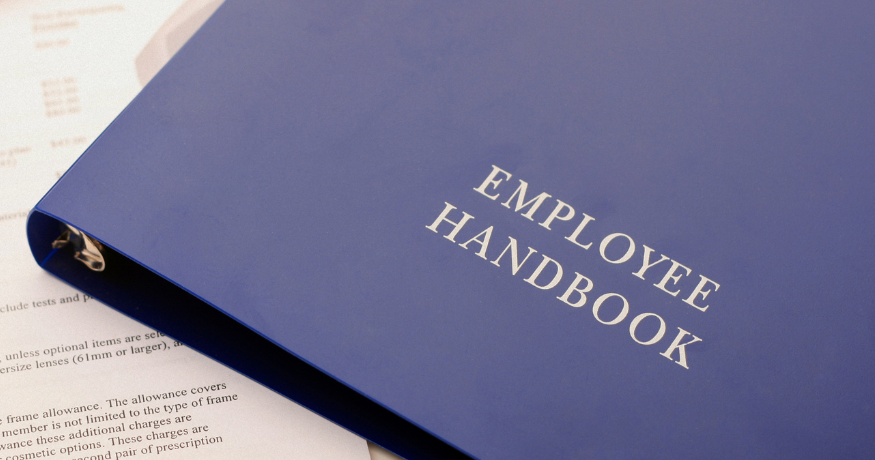If you’re growing a team without a clear, current employee handbook, you’re probably feeling it: mixed messages from managers, one-off policy decisions, repeat questions from new hires, and a nagging worry about compliance or a claim catching you off guard. Emails, old PDFs, and verbal “policy” don’t cut it. Your people need one source of truth. Your business needs consistency, protection, and a way to scale without reinventing answers every time.
This guide explains the real purpose of an employee handbook—and how to use it as a practical tool, not just a binder on a shelf. We’ll break down six concrete benefits for small and mid-sized companies, the key policies to include to stay compliant and fair, and quick tips to keep your handbook clear, current, and aligned with your culture. Built from what we see every day at Soteria HR, it’s straightforward, no fluff, and ready to apply. Let’s start by building it right the first time.
1. Build it right the first time with Soteria HR
A solid handbook does more than tick a box—it sets the tone, drives consistency, and keeps you aligned with employment laws. The purpose of an employee handbook is to clearly communicate expectations, outline key policies, and provide a trusted reference for leaders and employees. With Soteria HR, you get a handbook that’s compliant, practical, and matched to your culture from day one.
Why this matters
When policies live in inboxes or memory, managers improvise and employees guess. That invites inconsistent decisions, compliance gaps, and avoidable conflict. A clear, well-structured handbook gives everyone the same playbook—so you onboard faster, answer questions once, and minimize risk as you scale.
What to include in your handbook
Start with the essentials that every SMB needs, then tailor for your industry and state requirements. Soteria HR typically builds handbooks that cover:
- Culture and basics: Mission, values, at-will statement, EEO.
- Work standards: Hours, attendance, timekeeping, remote/hybrid norms.
- Code of conduct: Anti-harassment, respectful workplace, technology use, conflicts of interest.
- Pay and time off: Pay schedules, payroll deductions, PTO/holidays, overtime.
- Leaves and benefits: FMLA (if applicable), jury duty, bereavement, military leave, eligibility summaries.
- Safety and security: Injury reporting, workplace safety, data/privacy practices.
- Problem-solving: Complaint reporting, grievance steps, escalation paths.
- Acknowledgment: Receipt and non-contract disclaimer.
Quick tips to get it right
Small choices make a big difference. Keep it readable, consistent, and easy to apply in real life.
- Write for employees: Plain English, short sections, clear examples.
- Align and localize: Match policies to your culture and state laws.
- Train managers: Review changes and how to apply them consistently.
- Version it: Date every update and keep a signed acknowledgment on file.
2. Clarify culture, mission, and values from day one
New hires shouldn’t have to decode “how things work here.” The purpose of an employee handbook includes setting the cultural foundation early—what you stand for, how people succeed, and what “good” looks like in practice. Done well, this builds pride, speeds up productivity, and prevents misalignment later.
Why this matters
Culture drifts when it isn’t written down. Clear statements of mission, values, and work norms align managers, reduce mixed messages, and help employees make everyday decisions without constant escalation. It also reinforces EEO and respectful workplace commitments, which supports consistency and compliance from the start.
What to include in your handbook
Ground your culture sections in plain, actionable language. Make it easy for a new employee to recognize your values in daily behaviors, not just wall art.
- Welcome and origin story: Why you exist and who you serve.
- Mission, vision, values: Short, memorable, and practical.
- Values-in-action behaviors: Concrete examples of “what great looks like.”
- Leadership principles: How managers coach, decide, and communicate.
- EEO and respectful workplace: Zero tolerance for harassment, clear standards.
- Ways of working: Meeting norms, responsiveness, remote/hybrid etiquette.
Quick tips to get it right
Keep this section usable, not inspirational fluff. If employees can’t apply it Tuesday morning, rewrite it.
- Make values observable: Tie each to 2–3 behaviors.
- Connect to policies: Show how culture informs decisions.
- Use real examples: Short scenarios beat slogans.
- Keep it skimmable: One-page summary plus deeper detail as needed.
3. Set expectations to drive consistency and performance
Clear expectations remove guesswork. When everyone knows how to show up, what “good” looks like, and how work gets done, you get fewer mistakes, faster decisions, and fairer outcomes. The purpose of an employee handbook here is simple: make standards visible so managers don’t improvise and employees don’t have to guess.
Why this matters
Ambiguity breeds inconsistency—and inconsistency drives complaints. Handbooks that spell out responsibilities around attendance, timekeeping, safety, performance, and communication give managers a shared playbook and protect against “one-off” decisions. They also speed up onboarding and reduce repeat questions because the basics are documented and easy to find.
What to include in your handbook
Keep this section practical and action-oriented—what to do, who to tell, and when.
- Performance standards: How goals are set, feedback cadence, and review timelines.
- Work hours, attendance, timekeeping: Scheduling norms, overtime rules, and call-off steps before a missed shift.
- Communication norms: Response expectations, meeting etiquette, tools to use (and when).
- Technology and conduct: Proper use of email/Internet, cybersecurity basics, conflicts of interest.
- Problem-solving and discipline: How concerns are addressed and a non-contract disclaimer allowing case-by-case judgment.
Quick tips to get it right
Write for real life. If a new hire can’t follow it on day three, tighten it.
- Be specific on process: Name roles, channels, and timelines for call-offs and approvals.
- Use examples, not absolutes: Provide scenarios; avoid rigid language that ties leaders’ hands.
- Train to the standard: Review expectations with managers and align how they enforce them.
- Close the loop: Require read receipts/acknowledgments so you can confirm understanding.
4. Document key policies that keep you compliant
The purpose of an employee handbook isn’t just clarity—it’s compliance. Your handbook is where you codify the rules that keep you aligned with federal, state, and local requirements and give managers consistent guidance. Done right, it helps prevent fines, investigations, and headaches while making expectations crystal clear for every employee.
Why this matters
Regulators don’t accept “we told people in a meeting.” When laws change or a claim lands, a current, accessible handbook shows you exercised reasonable care and communicated standards consistently. It also gives employees a fair, transparent view of their rights and obligations—reducing confusion, complaints, and inconsistent decisions across teams.
What to include in your handbook
Start with plain-language summaries employees can act on, then point to full policies or forms as needed.
- EEO and anti-harassment: Clear standards, reporting steps, and zero-tolerance language.
- ADA accommodations: How to request support and who evaluates requests.
- Hours, breaks, overtime: Timekeeping rules, meal/rest breaks (where applicable), overtime eligibility and approvals.
- Pay practices: Pay schedules and permissible payroll deductions.
- Leave entitlements: FMLA (if applicable), military leave, jury duty, bereavement, and any state disability or paid leave programs.
- Safety and OSHA basics: Injury reporting, emergency procedures, and safety responsibilities.
- Technology and privacy: Acceptable use, data/security expectations, and monitoring disclosures.
- Social media guidance: Expectations without restricting protected concerted activity under the NLRA.
- Problem resolution: Complaint, investigation, and escalation paths.
- At-will and disclaimer: Not a contract; company may revise policies; acknowledgment required.
Quick tips to get it right
- Localize and date it: Reflect state/local rules and stamp every version.
- Be specific on process: Who to contact, forms to use, and timelines.
- Avoid rigid absolutes: Reserve discretion to handle cases individually.
- Train managers: Consistent application beats perfect prose.
- Audit regularly: Recheck annually—or sooner when laws change—and collect signed acknowledgments.
5. Reduce legal risk and protect against claims
A big purpose of an employee handbook is defense: preventing issues before they escalate and proving you acted with “reasonable care” if a claim arises. Clear policies, consistent application, and a signed acknowledgment can be the difference between a quick resolution and a costly dispute. When expectations and reporting paths are documented, you reduce ambiguity—the root cause of many complaints.
Why this matters
Most employment claims trace back to inconsistent treatment, unclear rules, or poor documentation. A thorough, current handbook shows your standards were communicated, your processes are fair, and employees knew where to turn for help. It equips managers with a shared playbook and helps your counsel demonstrate compliance and consistency if you face an investigation.
What to include in your handbook
Legal protection starts with precise, plain-English policies employees can follow and leaders can enforce—consistently.
- Anti-harassment and EEO: Standards, multiple reporting options (not just the supervisor), and an anti-retaliation statement.
- Complaint and investigation process: How to report, who investigates, expected timelines, and confidentiality to the extent possible.
- At-will and non-contract disclaimer: Clarify the handbook isn’t a contract and policies may be revised.
- Flexible discipline language: A framework that reserves discretion to address cases individually.
- Wage-hour basics: Timekeeping, overtime eligibility/approval, and meal/rest breaks where required.
- Leave rights: FMLA (if applicable), military, jury duty, bereavement, and state leave programs with eligibility summaries.
- ADA accommodations: How to request, what to expect, and who handles the interactive process.
- Social media/technology use: Guardrails that don’t restrict protected concerted activity.
Quick tips to get it right
A defensible handbook is current, acknowledged, and consistently applied.
- Collect acknowledgments: On hire and at every update; keep versions and dates.
- Train managers: Align on how to apply policies and document decisions.
- Avoid promises: No “will always” or guaranteed steps; reserve judgment.
- Localize and review: Update when laws change; legal review beats copy-paste.
- Provide alternatives: Offer more than one reporting path to avoid conflicts of interest.
- Make it accessible: Central location and language-appropriate versions if needed.
6. Give employees a trusted resource and clear channels for help
When people aren’t sure where to turn, issues linger—or head straight to outside agencies. A core purpose of an employee handbook is to give every employee a trusted, always-on resource that answers “Who do I contact? How do I report? What happens next?” That clarity builds confidence, speeds resolution, and keeps concerns in-house.
Why this matters
Employees hesitate to speak up when the process is vague, the only option is their manager, or they fear retaliation. Clear, multiple reporting paths and a simple, documented process reduce that friction. You create psychological safety, address problems earlier, and demonstrate reasonable care if a complaint is reviewed by a third party.
What to include in your handbook
Make the “get help” path unmistakable and practical—what to do, who to tell, and expected timelines.
- Multiple contacts: HR, manager, and an alternate.
- Anti-retaliation: Explicit, prominent, zero-tolerance.
- Reporting steps: How to submit, what info to include.
- Investigation outline: Who handles it and timing.
- Accommodation requests: ADA process and contact.
- Safety and injury reporting: Immediate steps and forms.
- Benefit resources/EAP: What’s available and access points.
- Confidentiality: What the company can and can’t promise.
Quick tips to get it right
Keep help easy to find, easy to use, and always current.
- Create a one-page “Get Help” map.
- Use role-based emails/phones, not names.
- Offer alternatives to the direct supervisor.
- Train managers to route issues, not gatekeep.
- Publish in multiple languages if needed.
Before you draft your handbook
If your handbook is going to work on day one and day 1,000, the pre-work matters. Clarify your goals, align leaders, and gather the right inputs before you write a word. You’ll avoid rewrites, speed adoption, and launch a handbook that feels like your company—not a template.
- Set the objective: What problems will the handbook solve and how will you measure success?
- Know your audience: Consider roles, locations, languages, and access (mobile vs. desktop).
- Map compliance scope: Identify jurisdictions and thresholds (e.g., FMLA eligibility, state leave, meal/rest rules).
- Inventory current practices: Collect policies, benefits, and unwritten norms you intend to keep or change.
- Define voice and guardrails: Plain language, at-will and non-contract disclaimers, and flexible discipline language.
- Assign ownership and cadence: Who maintains it and how often you review/update.
- Plan rollout: Manager training, acknowledgments, and a single source of truth employees can find fast.
Want a handbook that’s clear, compliant, and culture-fit without the guesswork? Build it with Soteria HR.




